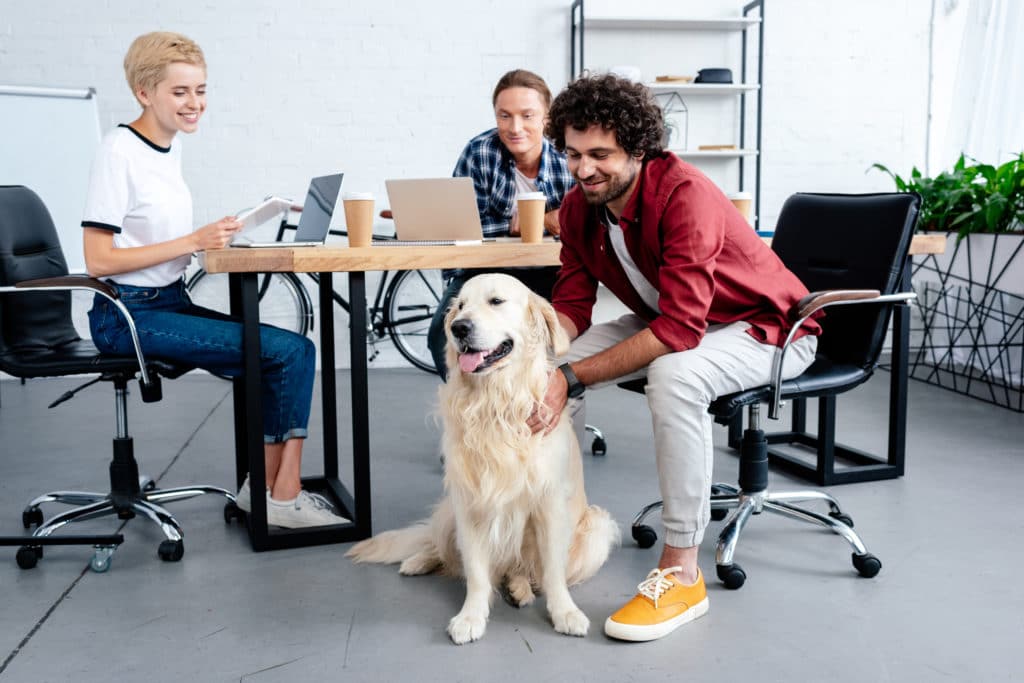Recent research seems to confirm what dog owners have known all along — that dogs in the workplace can lower stress and absenteeism while increasing employee productivity.
Companies are beginning to take note. The benefits of having dogs at work have become so widespread that, for an increasing number of companies, Take Your Dog to Work Day on June 20 won’t transform many offices so much as it will maintain their status quo — that dogs are welcome all the time. About 1.4 million owners take some 2.3 million dogs to work every day, according to an American Pet Products Association survey.
In fact, dogs are allowed daily inside the offices of Google, Amazon, and Ben & Jerry’s; they’re certainly annual guests at Hitachi Data Systems. The number of businesses signed up to host them this month has grown to 5,000 from a mere 300 when the national Take Your Dog to Work Day event was launched back in 1999.
“Our employees bring hundreds of dogs to work every day,” said Ty Rogers, spokesperson for Amazon. “The first dog to come to the office was a corgi named Rufus. He is still a part of the culture at Amazon; his name is even stamped on many of the door handles in the offices. Amazon even has dog biscuits available at the front desk and dog friendly water fountains scattered throughout the Seattle campus.”
Google recognizes that dogs can be a valued and important part of employees’ lives. According to a Google spokesperson, they believe that having dogs in the workplace often enhances the quality of their employees’ work life. However, dog owners must take complete responsibility for their pets. Owners are expected to recognize and adapt their actions to the reality that not all employees and visitors like dogs in the office, and in some cases people with allergies cannot tolerate being in close proximity to animals.
Of course, Mark Zuckerberg values dogs at Facebook. Cesar Millan, star of the hit TV show Dog Whisperer, visited Mark at his offices last year and was greeted by many dogs on campus. “Keeping dogs with their owners while they work is a good thing for dogs and humans as long as both understand rules, boundaries and limitations,” said Cesar.
At Zynga, the company that makes Facebook and mobile games including Words with Friends and Farmville, the ratio of employees to dogs is about nine to one. “Dogs have always been a part of Zynga culture. In fact, the company is named after one of our founder’s dogs — an American bull dog named Zinga that belonged to Mark Pincus,” explained Colleen McCreary, Chief People Officer. Zynga provides dog food and pet insurance for dogs on campus. They also have a “barking lot” for bathroom breaks.

- World Boxing Organization welterweight champion Manny Pacquiao has relied on his Jack Russell Pacman to help him train for the past four years.
- The Reverend Roy Snipes brings five furry friends to the Mass he serves at Our Lady of Guadeloupe Catholic Church in Mission, Texas, every Sunday.
- Many American presidents, including Barack Obama, have kept a dog around the Oval Office.
The research findings are no surprise to Dr. Matia Finn-Stevenson, who runs Yale University/School of the 21st Century’s Mutt-i-grees educational program. The experimental program uses dogs or dog puppets in elementary schools to teach children empathy, compassion and self-awareness. Educators who use the curriculum say it has reduced bullying, improved relationships between teachers, and reduced overall conflict in the classroom. The program is funded by a grant from The Cesar Millan Foundation and is in its third year of implementation, with thousands of schools throughout the United States and Canada using some form of the curriculum.

1. If possible, send out a simple “dog rules” memo to all your co-workers. The memo should address protocol for the day. Outline where dogs are allowed and where they are not, specify what to do in the case of a mess and rules for approaching a dog that’s new to the office, starting with “no touch, no talk, no eye contact.” Require all dogs to be spayed or neutered and up-to-date on all shots. Clearly define “off limits” areas of the office and be aware of colleagues that may be allergic to dogs.
2. Make sure you exercise your dog before you bring him or her to the office. You want to exhaust some of that pent-up morning energy before arriving at work.
3. Once you arrive, make a safe, cozy resting spot near you. This will keep your dog from acting territorial, and reduce separation anxiety.
4. Lead your dog around the office at the beginning of the day and let him smell his surroundings. This way you can introduce him in neutral territory.
5. If your dog’s stay is short, provide water but no food or treats. If your dog is staying for the entire day, you’ll have to provide food but make sure you exercise him before feeding.











